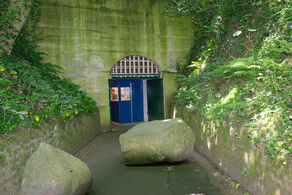German Underground Hospital Guernsey

The largest construction in the Channel Islands, the complex covers 7000 square metres and was dug out of solid rock by slave workers of many nationalities including Belgium, France, Holland, Poland, Russia, Spain and Guernsey. Construction began in the winter of 1940.
Admission: Children £1, Adults £3.50 Open Daily: April: 2pm - 4pm. May - October: 10am - 12pm and 2pm - 4pm. November & March: Limited opening Closed: December, January, February.
Admission: Children £1, Adults £3.50 Open Daily: April: 2pm - 4pm. May - October: 10am - 12pm and 2pm - 4pm. November & March: Limited opening Closed: December, January, February.
|
Perry's guide reference: Page 23 G4
Accessible using the following bus routes: 71 For further information please contact. German Military Underground Hospital Telephone: +44 (0) 1481 239100 |
The German Military Underground Hospital and Ammunition store is the largest structural reminder of the German Occupation in the Channel Islands. This maze of tunnels, almost invisible from the surface (except for the entrances) is built under a low hill in the heart of the Guernsey countryside. The escape shafts are no more than square holes level with the field surface above.
Hundreds of slave workers help to build it, working for the Todt Organisation. It took approximately three and a half years to excavate concrete and equip, yet it was only in actual use for around nine months. During that period hundreds of tons of ammunition were stored there, but the actual hospital was only used to accommodate troops brought from France where they where they were wounded in action against Liberating Forces. Designed to accommodate 500 patients, the Hospital, in an emergency, could have housed three or four times that number. Included in its medical staff were at least six German female nurses.
Today it is almost empty but there are still a few signs of the former hospital and stores. There were three tunnel entrances and five ventilating shafts. These shafts had iron ladders or concrete staircases for use as emergency exits. The shallowest is 45 feet, and the deepest is 75ft below the surface. The 75 feet shaft had a reservoir driven into one side which could hold thousands of gallons of water, thus making the tunnels independent of an outside supply.
The actual hospital was only in use for about six weeks, and it would not have been used had not several hundreds of German wounded been brought over from France soon after D-day. Their stay in this huge vault was scarcely beneficially, for after three or four weeks their faces were as white as sheets. After six week’s stay underground these sunshine-starved patients were removed to surface hospitals as there were still no signs of activity in Guernsey by Liberating Troops.
Hundreds of slave workers help to build it, working for the Todt Organisation. It took approximately three and a half years to excavate concrete and equip, yet it was only in actual use for around nine months. During that period hundreds of tons of ammunition were stored there, but the actual hospital was only used to accommodate troops brought from France where they where they were wounded in action against Liberating Forces. Designed to accommodate 500 patients, the Hospital, in an emergency, could have housed three or four times that number. Included in its medical staff were at least six German female nurses.
Today it is almost empty but there are still a few signs of the former hospital and stores. There were three tunnel entrances and five ventilating shafts. These shafts had iron ladders or concrete staircases for use as emergency exits. The shallowest is 45 feet, and the deepest is 75ft below the surface. The 75 feet shaft had a reservoir driven into one side which could hold thousands of gallons of water, thus making the tunnels independent of an outside supply.
The actual hospital was only in use for about six weeks, and it would not have been used had not several hundreds of German wounded been brought over from France soon after D-day. Their stay in this huge vault was scarcely beneficially, for after three or four weeks their faces were as white as sheets. After six week’s stay underground these sunshine-starved patients were removed to surface hospitals as there were still no signs of activity in Guernsey by Liberating Troops.
|
Click play to watch Underground Hospital Youtube video
|
|
Links

